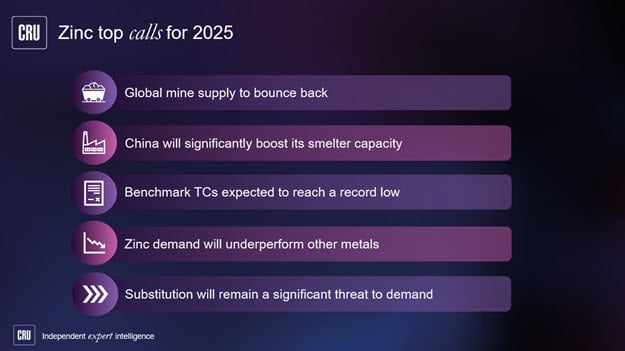Double digit demand loses YTD
CRU presented at the IZA’s European Zinc Conference in Dublin last week and conversations were dominated by concerns over how the rest of the year will play out for zinc demand. Our key takeaway is that the industry faces another turbulent year, with no region spared from its own set of challenges. The ongoing macroeconomic headwinds have hit European zinc demand hard, and many consumers spoke of double-digit demand losses y/y so far this year. However, demand losses of this magnitude have not been reflected in macroeconomic data so far, suggesting that consumer destocking and base effects after a strong start to the year in 2022 are to blame to some extent. That said, when we asked contacts how demand so far this year compared to pre-Covid demand levels in 2019, most said it was lower.
While European demand weakness was the main focus of many of our discussions, concern over the strength of consumption did not stop there, with all major regions struggling. This, in turn, makes it a challenging environment for sellers. Competitively priced metal continues to be offered widely, reflecting demand weakness in other regions, particularly Asia. The South American market is also facing soft demand, while freight rates out of the region remain elevated. This makes it hard for regional producers to compete in the export market with metal units from Asia, as Asian freight rates to the west have declined more steeply.
Concern for H2 zinc demand
There was little expectation amongst participants for a rebound in demand this year. Consumers are concerned as their order books remain weak and visibility is low, with enduse sectors not forecast to see much improvement given ongoing fiscal and monetary tightening, especially as we move into the summer months, which is a seasonally slow period for demand. Any pick-up in demand for the year is now anticipated in Q4, with sticky inflation being the largest downside risk. In the short run, one of the few upside risks for both price and demand comes from China where the import arbitrage has turned positive, albeit only just. Some Chinese smelters are struggling to remain profitable due to low zinc and sulphuric acid prices, so if smelters begin to cut back as demand picks up, we could see a sharp increase in imports. Any significant improvement in metal imports into China could shift momentum in both the physical market and in investor positioning on the LME as well as help reverse zinc’s recent price decline.
Downward premia pressure expected to continue in Europe and North America
European and North American premia are expected to continue declining as both markets face ongoing demand weakness and metal is readily available. Some participants did not rule out the possibility of European premia collapsing if the current weak demand environment continues for much longer. This market weakness has confirmed our view that Glencore’s Nordenham (175,000 t/y) smelter will not come back online this year. The CRU view is that European premia will continue to fall throughout the year. However, with many consumers in Europe having chosen to contract less on a long-term basis this year due to record-high premia, a solid demand recovery in H2 could lead to an increase in spot business and a tighter market. If Europe then has to compete with China and the USA for imports from the Asia region and elsewhere, this could at least put a floor under premia or even reverse the downward trend.

















